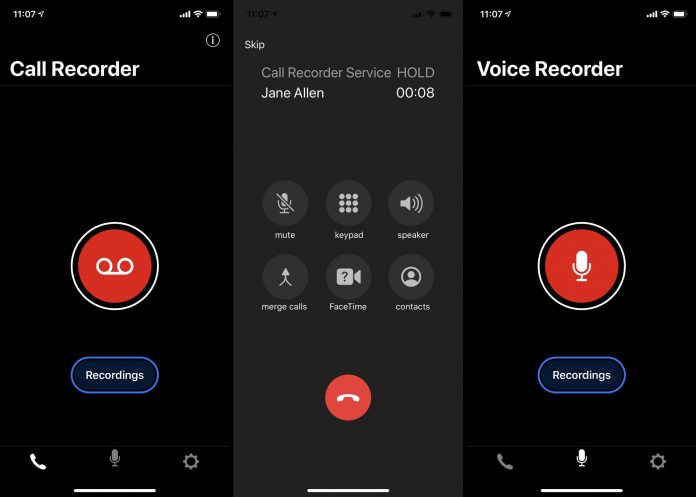One may need to record phone calls on their mobile phone for a variety of reasons. On Apple iPhones, there is no default feature to record calls. Even the screen-recording utility that is built into the phone stops working for the duration of an ongoing call. But, if you need to record phone calls on your iPhone, keep reading this article.
We have shared here some methods using which you can record phone calls on your iPhone.
Methods To Record Phone Calls On Your iPhone:
Local Access Number Service
This method makes use of an app that allows you to record phone calls. The most suitable app for this is TapeACall which works as a subscription service. Once you purchase the subscription, you have to use the app to merge the calls, which are then recorded and saved on the server of TapeACall. For incoming calls, you have to place the caller on hold to merge the local access number of TapeACall. For outgoing calls, you first call the number from the TapeACall app, then add the person on the call, and finally merge both calls.
Once your call is over, you can access the recordings within the app, which can also be shared as an MP3 file or a public URL. While it is a convoluted method of recording, all other recording apps work similarly.
Jailbreak Tweak
If you can get your iPhone jailbroken or have one already, you can purchase a Cydia or hAcx tweak that automatically records calls. The default feature of the app allows you to record all phone calls, although you can whitelist particular contacts whose calls you want to record. This tweak is one of the easiest ways to record calls of all the methods available. Sharing of recorded calls is easy as the tweak lets you transcribe recordings. The only disadvantage of this method is that it works only on jailbroken iPhones.
Google Voice App
Google Voice is another suitable option to record phone calls on an iPhone without any subscription fees. There is a small catch to it – only incoming calls can be recorded using the Google Voice app. A major flaw of this method is that the caller will be notified by the app as soon as you start the recording, even if the call is muted.
The advantages of using this app far outweigh the downsides. For example, to initiate or stop a call recording, you need to tap on “4” in the keypad of your app. Additionally, the recordings are available for listening on the Voicemail page of the Google Voice app. This app is great for recording work-related or business calls and is completely free to use.
QuickTime Player
If you have access to a Mac, QuickTime Player can record the calls on your iPhone. It even works with FaceTime calls, but you can not use headphones or earphones to record calls using this method. It only works if you are talking through the speaker of your phone. Also, answer the call using QuickTime Player instead of the iPhone.
The recording process starts with placing the call on speaker mode and then selecting “New Audio Recording” from the “File” option in the menu bar of QuickTime Player. Then access the drop-down menu available next to the record button, and ensure that you select the “Internal Microphone” option. To start the recording, click on the record button. Ensure that you are next to your Mac device so that the voice quality of the recording is high.
The main concern with this method of recording calls is portability. This is because it won’t always be possible for you to have your Mac device with you at all times. Also, since this method works only when you are talking in speaker mode, you might face intrusion of your privacy.
Tape Recorder
If any of the above methods don’t work, you can revert to the most effective method using a voice recorder similar to the QuickTime Player method. Although it is a crude method, it is very effective as you don’t have to carry the Mac with you at all times. You will still need to talk on the speaker mode to record calls using this method.
As discussed above, there are multiple ways to record phone calls on an iPhone. You have to decide which works best for you.
Experiencing difficulties with your Device, check out our “How To” page on how to resolve some of these issues.













